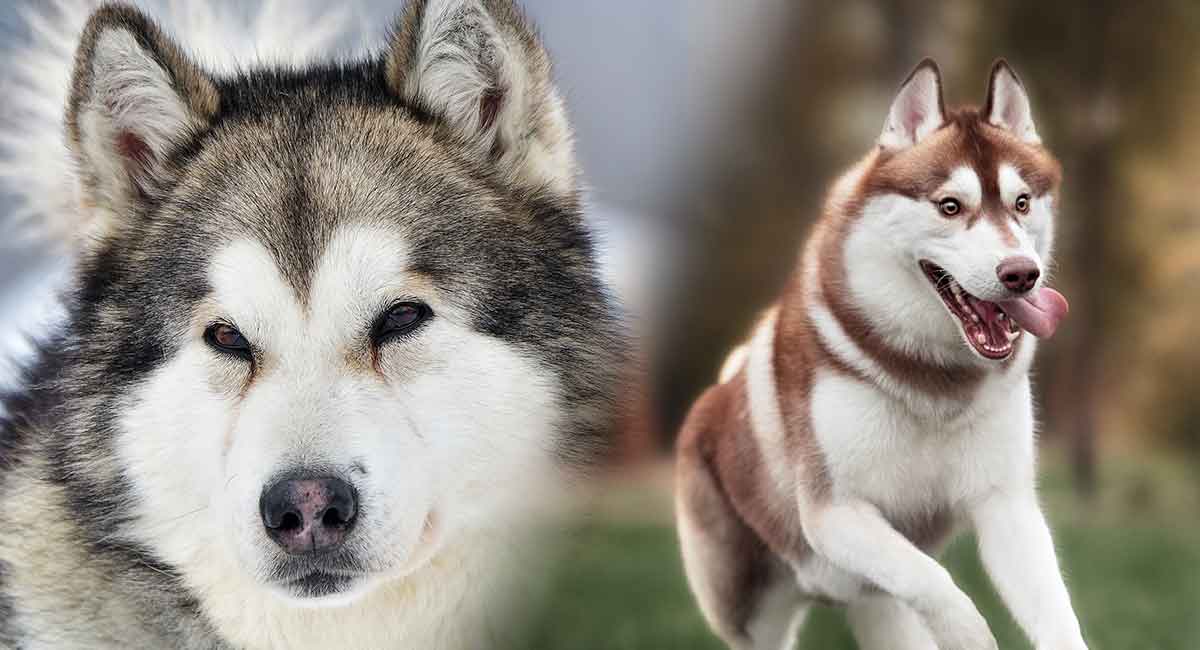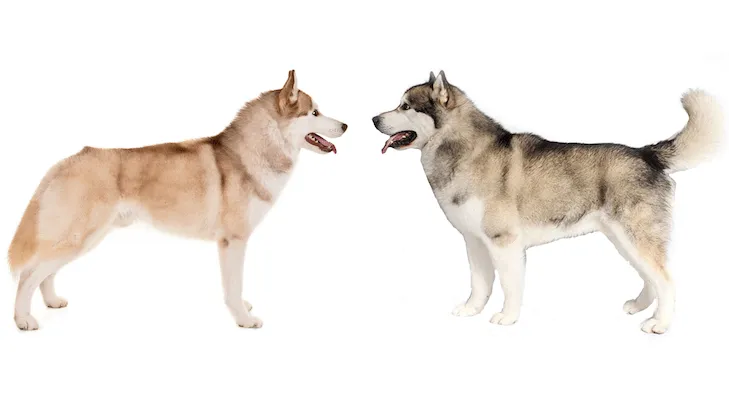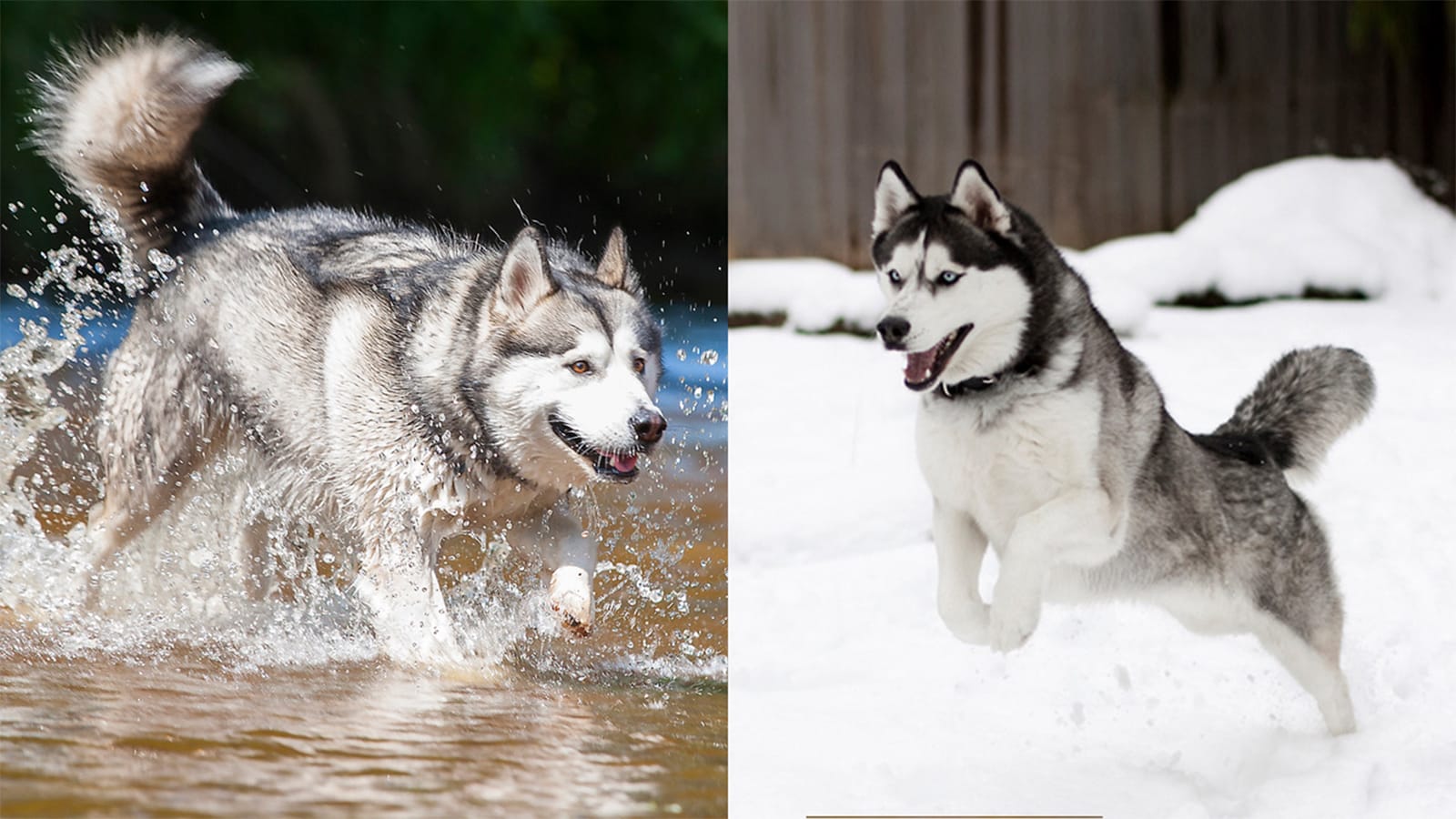Alaskan Malamutes and Huskies are two of the most popular dog breeds in the world. They are both beautiful, intelligent, and loyal dogs that are often confused with each other. Many people wonder if they are the same breed, or if there are any significant differences between them. This article aims to answer the question of whether Alaskan Malamutes and Huskies are the same breed or not.

At first glance, Alaskan Malamutes and Huskies look very similar. They are both medium to large-sized dogs with thick fur coats, erect ears, and bushy tails. However, there are some differences between the two breeds that set them apart. Alaskan Malamutes are larger and heavier than Huskies, with a more muscular build. They were originally bred for heavy work, such as pulling sleds and hauling freight, while Huskies were bred for speed and endurance in long-distance sled races. These differences in breeding have also resulted in differences in temperament and behavior between the two breeds.
Unlock Your Savings: Use Code HUSKY20 for $20 Off Fi Dog Collars!
Enhance your adventures with your Alaskan Malamute or Husky using the Fi Dog Collar, and save $20 off your purchase with promo code HUSKY20. These powerful breeds, known for their strength and endurance, can be hard to keep track of, but the Fi Dog Collar makes it easy.
With advanced GPS tracking and a geofence feature accessible via the Fi app, you can always ensure they’re safe and sound, whether in your yard or on a wilderness adventure. Dive into a new level of pet care at TryFi.com.
Origins and History
Alaskan Malamute Origins
The Alaskan Malamute is a large breed of domestic dog that originated from Alaska. They were originally bred by the Malamute people, an Inuit tribe, for hauling heavy loads over long distances in harsh winter conditions. The breed was also used for hunting and as a companion animal. The Alaskan Malamute is one of the oldest Arctic breeds and is closely related to the Siberian Husky and the Samoyed.
Siberian Husky Origins
The Siberian Husky is another breed of domestic dog that originated from Siberia. They were bred by the Chukchi people, a tribe of Siberian nomads, for sled pulling and transportation. The breed was also used for hunting and as a companion animal. The Siberian Husky is known for its endurance and ability to work in harsh winter conditions.

Despite their similar use and appearance, the Alaskan Malamute and Siberian Husky have distinct differences in their origins and breeding. While both breeds were developed for transportation and work in cold climates, the Alaskan Malamute was bred by the Malamute people for heavy hauling and the Siberian Husky was bred by the Chukchi people for speed and endurance.
Overall, the Alaskan Malamute and Siberian Husky are two distinct breeds with their own unique histories and characteristics.
Physical Characteristics
Size and Build
Alaskan Malamutes and Siberian Huskies are two distinct dog breeds that share many similarities in terms of their physical characteristics. Both breeds are classified as medium to large in size, with Alaskan Malamutes being slightly larger and heavier than Siberian Huskies.
Alaskan Malamutes typically stand between 23 and 25 inches tall at the shoulder and weigh between 75 and 100 pounds, while Siberian Huskies stand between 20 and 23.5 inches tall and weigh between 35 and 60 pounds. Malamutes have a broad, sturdy build with a deep chest and strong legs, while Huskies have a more slender build with a smaller chest and lighter bone structure.
Coat and Color
Both Alaskan Malamutes and Siberian Huskies have a thick double coat that provides insulation and protection from harsh weather conditions. However, there are some differences in the texture and color of their coats.
Malamutes have a dense, coarse outer coat and a softer undercoat, while Huskies have a softer and silkier outer coat and a denser undercoat. Malamutes come in a variety of colors, including shades of gray, black, sable, and red, while Huskies are typically black and white, gray and white, or red and white.
Facial Features
Alaskan Malamutes and Siberian Huskies have distinct facial features that set them apart from each other. Malamutes have a broad head with a wide, blunt muzzle and almond-shaped eyes that are usually brown. Huskies have a more fox-like appearance with a narrow, wedge-shaped head, a longer and more pointed muzzle, and eyes that can be blue, brown, or a combination of both.
In conclusion, while Alaskan Malamutes and Siberian Huskies share many physical characteristics, there are some notable differences in their size, coat, and facial features that distinguish them from each other.
Temperament and Behavior
Alaskan Malamute Temperament
The Alaskan Malamute is an intelligent and independent breed that is known for its loyalty and affection towards its family. They are friendly, playful, and have a gentle nature. They are also known for their strong work ethic, and they thrive when given a job to do. They are excellent with children and make great family pets.
However, due to their strong-willed nature, they can be difficult to train and require a firm and consistent hand. They have a strong prey drive and may not be suitable for homes with small pets. They also require a lot of exercise and mental stimulation to avoid destructive behavior.
Siberian Husky Behavior
The Siberian Husky is a friendly and outgoing breed that is known for its playful and energetic behavior. They are highly intelligent and independent, which can make them challenging to train. However, they are highly trainable with the right approach and respond well to positive reinforcement.
They are also known for their strong prey drive and may not be suitable for homes with small pets. They are excellent with children and make great family pets. However, they require a lot of exercise and mental stimulation to avoid destructive behavior.
Overall, while both the Alaskan Malamute and the Siberian Husky share some similarities in their temperament and behavior, they are distinct breeds with their own unique characteristics. It is important to research each breed thoroughly before deciding which one is right for you and your family.
Training and Exercise Needs

Exercise Requirements
Both Alaskan Malamutes and Huskies are highly energetic and require a lot of exercise to maintain their physical and mental health. They were originally bred as working dogs, so they have a lot of stamina and endurance. A daily exercise routine is necessary to keep them happy and healthy.
Malamutes and Huskies need at least 60 minutes of vigorous exercise per day. This can include running, hiking, or playing fetch. They also enjoy pulling sleds or carts, which can be a fun activity for them to engage in. It's important to note that these breeds shouldn't be left alone in a yard for extended periods of time as they can become bored and destructive.
Trainability and Intelligence
Malamutes and Huskies are intelligent dogs, but they can be stubborn and independent-minded. They require a firm and consistent training approach that involves positive reinforcement techniques. Harsh or punitive methods can lead to fear and aggression.
Both breeds are highly trainable, but they have different learning styles. Malamutes are more independent and may require more patience and persistence during training. Huskies, on the other hand, are more social and may respond better to training that involves interaction with other dogs or people.
Overall, Malamutes and Huskies are intelligent and trainable breeds that require a lot of exercise and a consistent training approach. With proper training and socialization, they can make great companions for active families.
Health and Lifespan
Common Health Issues
Both Alaskan Malamutes and Huskies are generally healthy breeds. However, like all dogs, they are prone to certain health issues. Alaskan Malamutes are particularly susceptible to hip dysplasia, a condition where the hip joint doesn't develop properly, which can lead to arthritis and lameness. They may also suffer from eye problems such as cataracts and progressive retinal atrophy.
On the other hand, Huskies are prone to a condition called zinc-responsive dermatosis, which causes skin problems. They may also suffer from eye problems such as corneal dystrophy and juvenile cataracts.
To keep your Alaskan Malamute or Husky healthy, it is important to provide them with regular exercise, a healthy diet, and routine veterinary check-ups.
Average Lifespan
The average lifespan of an Alaskan Malamute is around 10-12 years, while the average lifespan of a Husky is around 12-14 years. However, with proper care and attention, they can often live longer.
To ensure your Alaskan Malamute or Husky lives a long and healthy life, it is important to provide them with regular exercise, a healthy diet, and routine veterinary check-ups. Additionally, it is important to be aware of any potential health issues and to address them promptly with the help of a veterinarian.
Overall, while there are some differences in the health and lifespan of Alaskan Malamutes and Huskies, both breeds are generally healthy and can make wonderful pets for the right owner.
Suitability as Pets
Family Compatibility
Both Alaskan Malamutes and Huskies are great family pets, but they have different temperaments. Alaskan Malamutes tend to be more independent and stubborn, while Huskies are more social and affectionate. This means that Huskies may be better suited for families with children, while Alaskan Malamutes may be better for experienced dog owners who can handle their strong-willed nature.
It's important to note that both breeds have high energy levels and require plenty of exercise and mental stimulation. They also have a strong prey drive, so it's important to supervise them around small animals and keep them on a leash when outside.

Climate Adaptability
Both Alaskan Malamutes and Huskies are adapted to cold climates and have thick, double coats that keep them warm in sub-zero temperatures. However, they may struggle in hot and humid climates, as their thick coats can cause them to overheat.
If you live in a warm climate, it's important to keep your Alaskan Malamute or Husky cool by providing plenty of shade and access to water. You may also need to groom them more frequently to prevent their coats from becoming matted and uncomfortable.
Overall, both Alaskan Malamutes and Huskies can make great pets for the right family. It's important to consider their temperaments and energy levels, as well as your own lifestyle and climate, before deciding which breed is right for you.
Breed Recognition and Standards
Alaskan Malamutes and Siberian Huskies are two distinct breeds recognized by the American Kennel Club (AKC) and the United Kennel Club (UKC). The AKC recognizes the Alaskan Malamute as a working breed, while the Siberian Husky is recognized as a working and sporting breed.
The Alaskan Malamute and Siberian Husky have different breed standards that outline the ideal physical characteristics, temperament, and behavior for each breed. The breed standards also provide guidelines for breeders and judges to maintain the integrity of the breed.
According to the AKC breed standard, the Alaskan Malamute should have a thick, heavy coat that can be any color, a broad head, and a sturdy, well-muscled body. The breed standard also emphasizes the importance of a friendly and affectionate temperament.
The Siberian Husky breed standard, on the other hand, emphasizes the breed's athleticism and endurance. The breed should have a dense coat that is usually black, gray, or red, and a distinctive wolf-like appearance. The breed standard also emphasizes the importance of a friendly and outgoing temperament.
While the Alaskan Malamute and Siberian Husky share some physical similarities, such as a thick coat and a wolf-like appearance, they are different breeds with distinct breed standards. It is important for potential owners to research and understand the characteristics and needs of each breed before making a decision.
Care and Grooming Requirements
Alaskan Malamutes and Siberian Huskies are both double-coated breeds and require regular grooming to maintain their thick coats. The undercoat of these breeds is shed twice a year, and during this time, daily brushing is necessary to prevent matting and tangling.
In addition to regular brushing, both breeds require regular bathing to keep their coats clean and healthy. It is important to use a dog-specific shampoo and to thoroughly rinse the coat to avoid any skin irritation.
Both breeds are active and require daily exercise to keep them healthy and happy. A daily walk or run is recommended, and they also enjoy activities such as hiking, swimming, and playing fetch.
It is important to keep up with regular veterinary check-ups and vaccinations for both breeds. They are both prone to certain health issues, such as hip dysplasia and eye problems, so it is important to stay on top of their health care needs.
Overall, while Alaskan Malamutes and Siberian Huskies have similar care and grooming requirements, it is important to note that each individual dog may have specific needs that should be addressed by their owner and veterinarian.

Frequently Asked Questions
- What are the personality differences between Malamutes and Huskies?
- Both Malamutes and Huskies are intelligent and social breeds. However, Malamutes tend to be more independent and stubborn, while Huskies are more outgoing and playful. Malamutes also have a stronger prey drive than Huskies.
- Do Malamutes and Huskies differ in size?
- Yes, Malamutes are generally larger than Huskies. Malamutes can weigh up to 100 pounds, while Huskies typically weigh between 35 and 60 pounds.
- Can you compare the physical appearance of Malamutes and Huskies?
- Malamutes and Huskies have similar physical appearances, but there are some differences. Malamutes are bulkier and have a thicker coat, while Huskies are leaner and have a softer coat. Malamutes also have a broader head and shorter ears than Huskies.
- Are there distinct differences in the tails of Huskies and Malamutes?
- Yes, there are distinct differences in the tails of Huskies and Malamutes. Huskies have a sickle-shaped tail that curls over their back, while Malamutes have a plumed tail that is held over their back but not curled.
- Is it possible for a Malamute to breed with a Husky?
- Yes, it is possible for a Malamute to breed with a Husky. The resulting offspring are known as Alusky or Huskamute.
- Which breed tends to be more relaxed, Malamutes or Huskies?
- Neither breed is particularly relaxed, but Malamutes tend to be calmer and less energetic than Huskies. Malamutes are better suited for a more laid-back lifestyle, while Huskies require a lot of exercise and mental stimulation.




